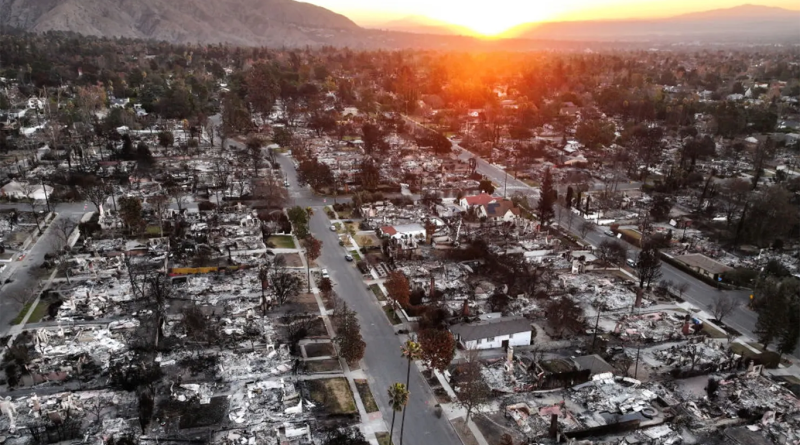How Los Angeles is Rebuilding Homes After Devastation from Wildfires
Los Angeles has once again faced devastation from wildfires, with the latest disaster leaving thousands of homes destroyed and entire neighborhoods in ruins. These fires, fueled by prolonged drought conditions and high winds, have resulted in staggering financial losses and the displacement of countless families. According to preliminary estimates, the recent wildfires have caused upwards of $250 billion in damages, making it one of the costliest natural disasters in California’s history.
Beyond financial costs, the fires have exposed critical weaknesses in how homes are built and how communities are planned in fire-prone areas. Many structures were not designed to withstand extreme fire conditions, and urban sprawl has increased the number of homes at risk. As rebuilding begins, city planners, architects, and government officials are calling for a new strategy—one that prioritizes fire-resistant materials, sustainable urban planning, and stronger policy enforcement to prevent future destruction.
While California has long grappled with wildfire recovery, this time is different. The state government and local officials are implementing aggressive reforms to change how and where homes are built. Homeowners, insurers, and developers must now comply with new building codes, stricter zoning laws, and advanced fireproofing measures. The goal is clear: to rebuild in a way that minimizes future losses and ensures communities can withstand wildfires more effectively.
The fire-resistant materials and architectural innovations shaping the next generation of homes
A major shift in rebuilding efforts involves using fire-resistant construction materials that can withstand extreme heat and embers. Traditional materials such as wood siding, asphalt shingles, and untreated fences have been linked to rapid fire spread, prompting a transition to more durable alternatives.
New homes will feature concrete and stucco exteriors, which are significantly more resistant to flames compared to wood. They will also include tempered glass windows designed to withstand high temperatures and reduce the risk of glass shattering from intense heat. Fire-resistant roofing materials, such as metal or clay tiles, will help prevent embers from igniting the structure. Additionally, noncombustible decks and fencing will replace traditional wooden designs that have contributed to past fire damage.
Architectural changes are also playing a crucial role in wildfire defense. Experts are focusing on defensible space, which involves creating buffer zones around homes to keep flammable vegetation at a safe distance. This strategy, already a requirement under California’s Wildland-Urban Interface building codes, is being expanded with additional state and local incentives for homeowners to maintain these protective spaces.
Additionally, roof sprinkler systems and ember-resistant vents are becoming standard in many high-risk areas. These systems are designed to stop embers from entering homes, which is a leading cause of fire spread. Smart home technology is also being integrated into fire detection systems, allowing homeowners to receive early warnings and take preventive action before a fire reaches their property.
How urban planning and zoning changes will protect communities
Beyond fire-resistant homes, Los Angeles is taking a broader approach by reforming urban planning and zoning laws to reduce wildfire risks across entire neighborhoods. The city is reconsidering where homes are built, how communities are designed, and what measures can be taken to limit fire spread in residential areas.
One of the most significant changes is the introduction of buffer zones, which serve as protective spaces between wildfire-prone areas and residential communities. These zones will be filled with noncombustible materials, fire-resistant vegetation, and open land that prevents flames from quickly reaching homes. City planners are also working to relocate high-risk housing developments away from fire-prone canyons and hillsides, where many past disasters have occurred.
Another crucial adjustment involves restricting urban sprawl into wildfire-prone zones. Historically, housing demand has pushed development into high-risk areas, leading to an increase in wildfire-related destruction. Now, Los Angeles is focusing on denser, more centralized communities, reducing the number of homes built in dangerous wildfire corridors.
Infrastructure improvements will also play a role in wildfire prevention. Widened roads, better evacuation routes, and underground power lines are part of the city’s new fire-safe design strategy. During past wildfires, narrow roads clogged with traffic became deadly bottlenecks, trapping residents as fires spread. In response, emergency planners are ensuring that new developments have multiple evacuation routes and clear access for fire crews.
Additionally, homeowners in high-risk areas will face new regulations that require them to maintain fire-resistant landscaping, comply with stricter building codes, and upgrade existing structures to meet modern fire safety standards. This could include replacing wooden decks, installing ember-resistant vents, and reinforcing roofs with fire-resistant materials.
How policy changes and government funding will shape the rebuilding process
To ensure the success of these wildfire-resistant rebuilding efforts, Los Angeles and the state of California are implementing new policies and financial incentives that support homeowners and developers in adopting safer construction methods.
One of the biggest challenges in wildfire recovery is homeowners securing insurance coverage. After recent wildfires, many insurance companies raised premiums or stopped offering coverage in high-risk areas altogether. In response, the California government has expanded the FAIR Plan, the state-backed wildfire insurance program, to help residents access coverage for rebuilding. Additionally, new legislation aims to require private insurers to provide coverage for homes that meet strict fireproofing standards.
The state is also offering grants and low-interest loans for homeowners to rebuild with fire-resistant materials and comply with updated safety codes. Programs such as California’s Wildfire Resilience Initiative are providing funding to retrofit existing homes with fire-resistant features, helping residents prepare for future wildfires without bearing the full financial burden.
At the federal level, the Federal Emergency Management Agency and the Department of Housing and Urban Development are stepping in with disaster relief funds and rebuilding grants. These funds will help both individual homeowners and local governments rebuild infrastructure, upgrade emergency response systems, and implement new fire prevention measures. Meanwhile, city officials are working on accelerating the permitting process for fire-resistant rebuilding projects.
Sources:
To keep up-to-date with our latest construction news, subscribe to our newsletter today.
